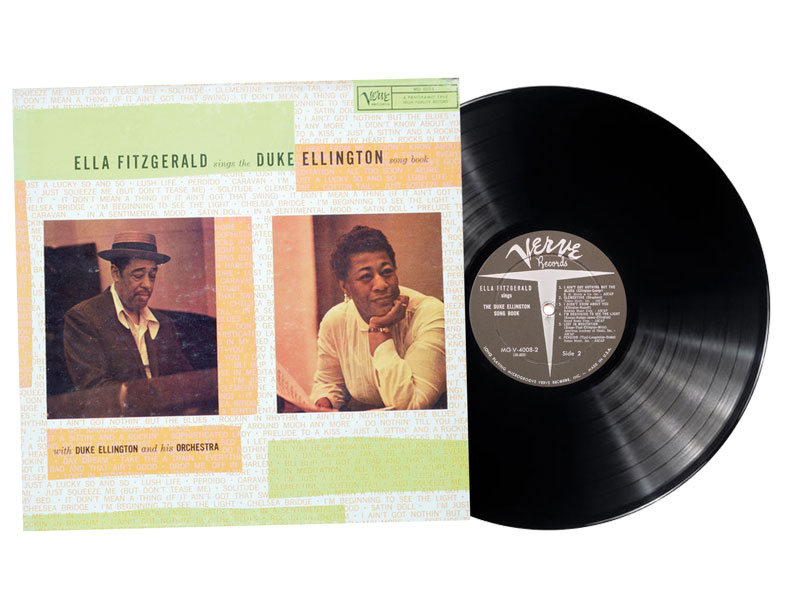Across the tracks: Ella Fitzgerald's recording of Duke Ellington's ‘I Ain’t Got Nothin’ But The Blues’
Friday, January 19, 2018
Brian Priestley takes the opportunity to put Ella Fitzgerald’s soulful 1957 version of Ellington’s ‘I Ain’t Got Nothin’ But The Blues’ under the microscope It’s well known that Ella Fitzgerald had the most virtuosic vocal instrument in jazz, at least until Sarah Vaughan, and she’s almost universally revered.
In the early part of her career with Chick Webb’s band, and then continuing with the Decca label, she recorded her share of undistinguished material. But, by the mid-1950s when she moved to her manager Norman Granz’s label Verve, she tackled ‘songbooks’ of the previous three decades by Porter, Rodgers, Gershwin etc. The chosen song from her June 1957 set of Ellington numbers is not one of their best known, but it is full of interest.
Despite its conventional AABA design, there’s a rather unusual aspect to the tune, related to the placing of the vocal phrases over their backing. Pop-music history is full of melodies with two or three introductory notes to be sung before the downbeat – and Fats Domino fans will recall the 1920s standard ‘My Blue Heaven’, which has four. But until Duke’s 1935 ‘In A Sentimental Mood’, there was never one with a whole six syllables preceding the first bar (though the same opening phrase occurs in ‘Someone To Watch Over Me’ and ‘P.S. I Love You’, in those cases it falls after the start of the first bar, which has a rather different effect).
This became more common in later decades but, when ‘I Ain’t Got Nothin’ But The Blues’ appeared, Ellington had considerable recent success with two such songs that were also originally instrumentals, namely ‘Don’t Get Around Much Any More’ (its newly added lyrics inspiring several cover versions in 1943) and ‘Do Nothin’ Till You Hear From Me’ (ditto in 1944). It seems that ‘I Ain’t Got…’, first recorded late 1944, was a deliberate follow-up with lyrics already attached but, in popularity and longevity, it was overshadowed by the same session’s ‘I’m Beginning To See The Light’.
Concerning this initial collaboration with Ellington, Ella’s and Granz’s biographers have reiterated the latter’s rather damning comment of 20 years later: “Duke failed to do a single arrangement, Ella had to use the band’s regular arrangements.” Since many tracks are in different keys to the originals, it doesn’t take a genius to realise Granz was exaggerating. Ella said something more revealing: “It was a panic scene, with Duke almost making up the arrangements as we went along”, which clearly relates to Ellington’s rather unorthodox way of rehearsing new scores in the studio. Indeed, the 1998 3CD reissue included half-an-hour of Ellington, Billy Strayhorn, Ella and the band working together on their new version of Strayhorn’s ‘Chelsea Bridge’.
 ‘I Ain’t Got…’, on the other hand, is a more straightforward example of a new chart (by Ellington rather than Strayhorn). The original 1944 recording is fairly laidback, with Al Hibbler intoning the ironic words: “Ain’t got the change of a nickel/Ain’t got no bounce in my shoes” and, most interestingly, with vocalist Kay Davis singing wordless responses in the style associated with Johnny Hodges. The 1957 treatment, despite an identical tempo, is more soulful, thanks to Ellington’s triplet-based intro and Sam Woodyard’s insistent off-beat, while the theme-statements by Harry Carney (0’08”) and Hodges (0’31”) evoke responses from a funky trio of muted trumpets.
‘I Ain’t Got…’, on the other hand, is a more straightforward example of a new chart (by Ellington rather than Strayhorn). The original 1944 recording is fairly laidback, with Al Hibbler intoning the ironic words: “Ain’t got the change of a nickel/Ain’t got no bounce in my shoes” and, most interestingly, with vocalist Kay Davis singing wordless responses in the style associated with Johnny Hodges. The 1957 treatment, despite an identical tempo, is more soulful, thanks to Ellington’s triplet-based intro and Sam Woodyard’s insistent off-beat, while the theme-statements by Harry Carney (0’08”) and Hodges (0’31”) evoke responses from a funky trio of muted trumpets.
When Ella finally appears (0’55”), hanging superbly behind the beat, she sings the written melody quite straight, while backed by a quiet but angular bluesy unison line for the trombones. Even in the B-section of the opening chorus (1’45”) with the lyrics “When trumpets flare up…”, Ellington’s trumpets are not in evidence but just harmonised trombones and bluesy unison saxophones, all at moderate volume. The anticipated high-spot comes at the start of the second chorus (2’31”) with the brass suddenly shouting out the rhythm of the tune in Duke’s patented polytonal chords, and Ella doing responses that retain the words but dramatically open up the melody. The piano also becomes more active in a backing role, right up to Ella’s verbal coda (4’11”), which is then inevitably capped by the polytonal brass one more time.
The saying “simple ain’t easy”, sometimes attributed to Monk, comes to mind when surveying a performance such as this. It might seem unsuitable to focus on Fitzgerald in an ostensibly blues context – in the same way, people claim that sad ballads were not her forte since she always sounded too happy. Her great predecessor Louis Armstrong, however, demonstrated for all time that the genius of jazz was to make blues themes and blue notes into a vehicle for psychological release. Whether putting her energy into scatting like there’s no tomorrow, or bringing out the poignancy of a well-written tear-jerker, Ella was inimitable. This track, like so many others, shows her at her best.
Photo of Ella Fitzgerald, courtesy Herman Leonard
This article originally appeared in the July 2017 issue of Jazzwise. To find out more about subscribing, please visit: http://www.jazzwisemagazine.com/subscribe